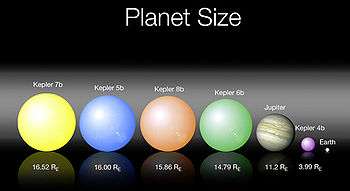Kepler-4b
| Exoplanet | List of exoplanets | |
|---|---|---|
 | ||
| Parent star | ||
| Star | Kepler-4[1] | |
| Constellation | Draco | |
| Right ascension | (α) | 19h 2m 27.7s |
| Declination | (δ) | +50° 8′ 8.7″ |
| Apparent magnitude | (mV) | 12.6[1] |
| Distance | 1631 ly (550[1] pc) | |
| Mass | (m) | 1.092 ± 0.073[2] M☉ |
| Radius | (r) | 1.533 ± 0.040[2] R☉ |
| Temperature | (T) | 5857[1] K |
| Metallicity | [Fe/H] | 0.17[1] |
| Age | 4.5[3] Gyr | |
| Physical characteristics | ||
| Mass | (m) | .077[1] MJ |
| Radius | (r) | 0.357[1] RJ (3.878 R⊕) |
| Stellar flux | (F⊙) | ~168 ⊕ |
| Temperature | (T) | 1650[1] |
| Orbital elements | ||
| Semi-major axis | (a) | .04558[1] AU |
| Eccentricity | (e) | 0.25 ± 0.12[4] |
| Orbital period | (P) | 3.2135[1] d |
| Inclination | (i) | 89.76[1]° |
| Discovery information | ||
| Discovery date | 2010-01-04[5] | |
| Discoverer(s) | ||
| Discovery method | Transit (Kepler Mission)[6] | |
| Other detection methods | Radial velocity | |
| Discovery status | Conference announcement[5] | |
Kepler-4b, initially known as KOI 7.01, is an extrasolar planet first detected as a transit by the Kepler spacecraft. Its radius and mass are similar to that of Neptune; however, due to its proximity to its host star, it is substantially hotter than any planet in the Solar System.[1][7] The planet's discovery was announced on January 4, 2010 in Washington, D.C. along with four other planets that were initially detected by the Kepler spacecraft and subsequently confirmed by telescopes at the W.M. Keck Observatory.
Nomenclature and history
Kepler-4b was named because it was the first planet discovered in the orbit of its star, Kepler-4. The star was, in turn, named for the Kepler Mission, a NASA satellite whose purpose is to discover Earth-like planets in a section of the sky between constellations Cygnus and Lyra using the transit method. Using this method, Kepler notes small and steady decreases in a star's brightness that are measured as a planet crosses in front of it.[6] Initially, Kepler-4b was detected as a transit event by the Kepler telescope and considered a Kepler Object of Interest with the designation KOI 7.01.[8]
Subsequent radial velocity measurements by the High Resolution Echelle Spectrometer on the telescopes of W.M. Keck Observatory confirmed the planetary nature of the transit event and established a mass estimate for the planet.[9] The planet's existence was announced on January 4, 2010 along with four other planets detected by Kepler: Kepler-5b, 6b, 7b and 8b[7] at the 215th meeting of the American Astronomical Society in Washington, D.C.[5]
Host star
Kepler-4 is located within the Draco constellation on the sky, and is approximately 550 parsecs from the Solar System. It has an effective temperature almost identical to the Sun at 5857 Kelvin, but a mass and radius that are somewhat larger than the sun: respectively, 1.092 and 1.533 .[2] The star is thought to be around 4.5 billion years old, and at or very near the end of its main-sequence hydrogen burning phase. In several tens of millions of years it will likely become a subgiant star.[9]
Characteristics
Kepler-4b orbits its host star in 3.213 days at a distance of 0.046 AU.[9] This places it almost 10 times closer to its star than Mercury is to the Sun. Consequently, Kepler-4b is thought to be extremely hot, with an equilibrium temperature greater than 1700 Kelvin (2600 Fahrenheit).[4] The planet is estimated to be 25 times more massive than the Earth with a radius that is 4 times greater than the Earth.[9] This makes it similar to Neptune in terms of size and mass, but with a temperature that is not comparable to any planet in the Solar System (Venus, the hottest planet, is only 735 Kelvin). Kepler-4b's eccentricity was assumed to be 0, however an independent reanalysis of the discovery data found a value of 0.25 ± 0.12.[4]

See also
References
- 1 2 3 4 5 6 7 8 9 10 11 12 "Summary Table of Kepler Discoveries". NASA. 2010-03-15. Retrieved 2010-03-18.
- 1 2 3 Huber, Daniel; et al. (2013). "Fundamental Properties of Kepler Planet-candidate Host Stars using Asteroseismology". The Astrophysical Journal. 767 (2). 127. arXiv:1302.2624
 . Bibcode:2013ApJ...767..127H. doi:10.1088/0004-637X/767/2/127.
. Bibcode:2013ApJ...767..127H. doi:10.1088/0004-637X/767/2/127. - ↑ Jean Schneider (2010). "Planet Kepler-4 b". Extrasolar Planets Encyclopaedia. Jean Schneider. Retrieved 5 August 2012.
- 1 2 3 Kipping, David; Bakos, Gáspár (2011). "An Independent Analysis of Kepler-4b through Kepler-8b". The Astrophysical Journal. 730 (1). 50. arXiv:1004.3538
 . Bibcode:2011ApJ...730...50K. doi:10.1088/0004-637X/730/1/50.
. Bibcode:2011ApJ...730...50K. doi:10.1088/0004-637X/730/1/50. - 1 2 3 Rich Talcott (5 January 2010). "215th AAS meeting update: Kepler discoveries the talk of the town". Astronomy.com. Astronomy magazine. Retrieved 11 March 2011.
- 1 2 "Kepler: About the Mission". Kepler Mission. NASA. 2011. Retrieved 11 March 2011.
- 1 2 Ron Cowen (2010-01-04). "Kepler space telescope finds its first extrasolar planets". Science News. Retrieved 2010-01-04.
- ↑ Borucki, William J; et al. (2011-02-01). "Characteristics of planetary candidates observed by Kepler, II: Analysis of the first four months of data" (PDF). http://kepler.nasa.gov. Retrieved 2011-03-07. External link in
|publisher=(help) - 1 2 3 4 Borucki, William J.; et al. (2010). "Kepler-4b: A Hot Neptune-like Planet of a G0 Star Near Main-sequence Turnoff". The Astrophysical Journal Letters. 713 (2): L126. arXiv:1001.0604
 . Bibcode:2010ApJ...713L.126B. doi:10.1088/2041-8205/713/2/L126.
. Bibcode:2010ApJ...713L.126B. doi:10.1088/2041-8205/713/2/L126.
External links
![]() Media related to Kepler-4 b at Wikimedia Commons
Media related to Kepler-4 b at Wikimedia Commons
Coordinates: ![]() 19h 2m 27.7s, +50° 8′ 8.7″
19h 2m 27.7s, +50° 8′ 8.7″